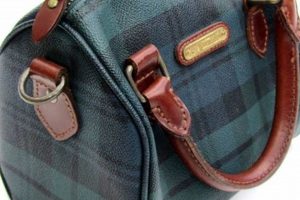A classic shoulder bag silhouette produced by Coach, characterized by its open-top design and often featuring a drawstring or other closure mechanism, constitutes a sought-after item in the pre-owned market. These bags, typically crafted from leather, represent a specific era of the brand’s production and design aesthetic. For example, a Coach bag from the 1970s with a simple, unlined interior and solid brass hardware exemplifies this category.
The enduring appeal of these older models lies in their durability, timeless design, and association with a particular period of fashion history. Their value often stems from the quality of materials used in their construction, as well as the scarcity of specific models or variations. Acquiring one of these accessories allows individuals to own a piece of the brand’s heritage and contribute to sustainable consumption practices by extending the lifespan of existing goods.
The following sections will delve into the identification of authentic examples, explore factors influencing their valuation, and provide guidance on the proper care and maintenance necessary to preserve these cherished items.
Essential Guidance
Proper evaluation and care are critical when considering acquisition or ownership. These insights aim to offer knowledgeable guidance.
Tip 1: Examine Stitching and Hardware. Scrutinize the stitching for consistency, evenness, and the use of high-quality thread. Authentic examples demonstrate meticulous craftsmanship. Assess the hardware, including buckles and clasps; solid brass is often indicative of older, higher-quality production.
Tip 2: Inspect the Leather. The quality of the leather is paramount. Full-grain leather, which develops a patina over time, is a hallmark of many classic designs. Pay attention to the texture and suppleness; avoid overly stiff or plastic-feeling materials.
Tip 3: Verify the Creed Patch and Serial Number. Locate the creed patch inside the bag. It should contain a unique serial number, typically stamped, not printed. Research the serial number to ensure it aligns with known production periods and styles. Note that the presence of a creed and serial number does not guarantee authenticity, but its absence is a strong indicator of a counterfeit.
Tip 4: Assess the Lining (if present). Many older models are unlined, a characteristic feature. If a lining exists, evaluate its material and construction. Substandard linings are common in replicas.
Tip 5: Consider the Overall Condition. Assess wear and tear, including scratches, stains, and any repairs. While imperfections are expected in pre-owned items, excessive damage can significantly impact value and longevity.
Tip 6: Compare to Known Authentic Examples. Thorough research is crucial. Compare the item in question to images and descriptions of authenticated examples. Pay attention to details such as dimensions, strap length, and hardware placement.
Tip 7: Seek Expert Opinion. If uncertainty persists, consult with a professional authenticator specializing in vintage handbags. Their expertise can provide a definitive assessment.
Implementing these strategies significantly improves the likelihood of acquiring an authentic and well-preserved item. Careful assessment ensures a valuable and long-lasting addition to any collection.
The succeeding section addresses the topic of maintaining this prized possession and methods for appropriate preservation.
1. Leather Quality
The quality of leather used in the manufacturing process directly impacts the desirability, longevity, and value of a vintage Coach bucket bag. The material’s characteristics influence its appearance, feel, and resistance to wear, making it a critical factor in assessing its overall condition and authenticity.
- Type of Leather
Early Coach bucket bags were primarily crafted from full-grain cowhide leather, known for its durability, natural grain, and ability to develop a rich patina over time. This type of leather retains the inherent markings of the hide, showcasing its authenticity. Subsequent production may have incorporated different leather types with varying levels of quality, affecting the bag’s resilience and aesthetic appeal.
- Tanning Process
The tanning process significantly influences the leather’s texture, suppleness, and colorfastness. Vegetable-tanned leather, often used in older models, retains a more natural feel and ages gracefully. Chrome-tanned leather, while faster to produce, may exhibit a less desirable plastic-like texture. Identifying the tanning process can provide clues about the bag’s age and quality.
- Construction and Finishing
The quality of the leather is further reflected in the construction and finishing techniques employed. Clean, even stitching and well-finished edges indicate a higher level of craftsmanship. Creasing, cracking, or excessive stiffness may suggest inferior leather quality or improper care, detracting from the bag’s value and usability.
- Patina Development
The patina that develops on full-grain leather over time is a highly valued characteristic. This natural aging process results in a unique sheen and depth of color, enhancing the bag’s character. A well-developed patina is often seen as a sign of authenticity and careful use, contributing to the bag’s overall appeal and collectibility. Conversely, leather that remains dull or shows signs of cracking may indicate poor quality or improper storage.
The interplay between leather type, tanning process, construction, and patina development collectively determines the enduring appeal and value of a vintage Coach bucket bag. Assessing these factors provides a comprehensive understanding of the material’s contribution to the bag’s overall character and longevity.
2. Hardware Integrity
The condition and authenticity of the hardware on a Coach bucket bag significantly influence its overall value and historical accuracy. Solid brass, a common material in pre-1994 models, is a marker of quality and a key identifier for determining the bag’s era. The integrity of this hardware, encompassing buckles, clasps, zippers, and d-rings, speaks to the bag’s level of preservation and history of use. Corrosion, breakage, or replacement with non-original components detract from its value and can indicate inconsistent maintenance. For example, a tarnished but intact solid brass buckle suggests age and authenticity, while a modern, plated replacement undermines the piece’s vintage status.
Specific hardware details, such as the style of the turn-lock or the design of the d-rings, are often unique to particular production years or model lines. Identifying these features requires careful examination and comparison to known authentic examples. Counterfeit bags frequently exhibit discrepancies in hardware design or material, serving as a tell-tale sign. The functionality of the hardware also plays a crucial role; a broken zipper or a faulty clasp diminishes the bag’s utility and, consequently, its market value. Therefore, a thorough assessment of hardware is integral to evaluating a vintage Coach bag. In essence, the original hardware serves as a reliable ‘time stamp’ on its authenticity.
In summary, assessing hardware integrity is critical for determining authenticity, evaluating condition, and preserving the historical accuracy of a Coach bucket bag. Careful examination of the materials, design, and functionality of the hardware provides valuable insights into the bag’s origin, use, and overall value. Maintaining original hardware is paramount for owners to retain the piece’s historical context and aesthetic appeal.
3. Creed Authenticity
The “creed,” a stamped leather patch located within a Coach bag, serves as a critical indicator of authenticity, particularly in the context of the older models. This patch typically contains a brief statement about the brand’s heritage and manufacturing process, alongside a unique serial number. The presence, legibility, and accuracy of this creed are essential components in verifying the provenance of a vintage Coach bucket bag. For instance, a missing creed, or one exhibiting inconsistencies in font, stamping depth, or creed text relative to known authentic examples, raises immediate suspicion regarding the bag’s genuineness. The serial number, in particular, can be cross-referenced against Coach’s historical records or authentication databases to confirm its validity and association with a specific production year or style. A failure to align with established authentication parameters suggests a counterfeit product.
Further, the practical significance of understanding creed authenticity lies in its direct impact on valuation and collectibility. A confirmed authentic creed significantly enhances the market value of a vintage Coach bucket bag, as it provides tangible evidence of its origin and adherence to the brand’s standards. Conversely, a questionable or absent creed diminishes the item’s value and marketability. Examples include instances where meticulous collectors have paid premiums for bags with clear, verifiable creeds, while similar bags lacking this feature have sold for significantly lower prices. Moreover, the knowledge of creed characteristics empowers buyers to make informed purchasing decisions, minimizing the risk of acquiring counterfeit goods and safeguarding their investment.
In summary, creed authenticity represents a cornerstone in the authentication process of vintage Coach bucket bags. The creed’s presence, accuracy, and correspondence with established authentication standards directly influence the bag’s value and credibility. Recognizing the nuances of creed characteristics is therefore vital for both collectors and buyers seeking to navigate the pre-owned market and ensure the integrity of their acquisitions. The absence of a verifiable creed presents a significant challenge in establishing provenance, underscoring the importance of thorough examination and informed decision-making.
4. Silhouette Evolution
The evolution of the Coach bucket bag’s silhouette reflects broader shifts in fashion trends and the brand’s strategic adaptations to market demands. Early iterations prioritized functionality and minimalist design, characterized by simple, unadorned shapes and a focus on the quality of leather. These early silhouettes, often featuring a basic cylindrical or slightly tapered body, were intended for practical everyday use. As the brand matured, the silhouette evolved to incorporate more stylized elements, reflecting contemporary aesthetics. This includes variations in size, the addition of external pockets, and experimentation with different closure mechanisms, such as drawstrings, flaps, and turn-locks. The cause of these changes can be directly attributed to the brand’s desire to appeal to a wider consumer base and compete effectively within the evolving handbag market. The importance of this evolution lies in its impact on the bag’s collectibility and perceived value.
Real-life examples illustrate this shift. Compare the original Coach Bucket Bag, model 9085, with its simple, unlined construction and basic silhouette, to later models featuring logo-embossed leather and more elaborate detailing. The early model appeals to collectors seeking authenticity and minimalist design, while subsequent iterations cater to consumers valuing brand recognition and contemporary styling. Understanding silhouette evolution is practically significant for both buyers and sellers. It allows for accurate identification of a bag’s production period and helps determine its relative rarity. For instance, a limited-edition bucket bag with a unique silhouette and specific hardware features may command a premium price due to its scarcity and desirability among collectors. Conversely, mass-produced variations with less distinctive silhouettes may be more readily available and, consequently, less valuable.
In summary, the silhouette evolution of the Coach bucket bag is inextricably linked to its historical context and market position. This evolution encompasses shifts in design aesthetics, functionality, and brand identity, reflecting broader trends within the fashion industry. Accurately tracing and understanding these silhouette variations is vital for assessing authenticity, determining value, and appreciating the bag’s place within the Coach brand’s legacy. Challenges in this assessment include the sheer number of variations produced over the years and the potential for misidentification due to subtle design differences. However, meticulous research and careful comparison to known authentic examples remain essential for navigating the complexities of the vintage Coach market and appreciating the enduring appeal of this classic accessory.
5. Rarity Influence
The scarcity of specific Coach bucket bag models significantly impacts their desirability and market value within the vintage accessories market. The convergence of factors, including limited production runs, special editions, and unique design features, contributes to an item’s rarity, thereby influencing its demand and price.
- Limited Production Runs
Bags manufactured in small quantities during specific years acquire heightened value due to their limited availability. For instance, a model produced exclusively for a single season may become highly sought after by collectors, driving up its price. These bags often feature unique design elements or materials not found in standard production models.
- Special Editions and Collaborations
Coach has released special editions and collaborated with designers or artists, resulting in bags with distinct characteristics. These collaborations produce bags that reflect the design sensibilities of both Coach and the collaborating party, creating unique and limited pieces. Collectors value these bags for their distinctive aesthetics and the prestige associated with the collaboration, contributing to their elevated market value.
- Material and Hardware Variations
Specific materials or hardware finishes used in a limited number of bags contribute to their rarity. Examples include bags crafted from exotic leathers or featuring unique hardware finishes that were discontinued or only used in a small production run. Collectors actively seek these variations due to their unique aesthetic appeal and the difficulty of acquiring them.
- Historical Significance
Bags associated with significant historical events or figures may acquire increased value due to their provenance. For example, a bag known to have been owned by a notable individual or featured in a significant media event can command a premium price. This historical association adds a layer of intrigue and collectibility to the item.
The confluence of these factors underscores the considerable influence of rarity on the vintage Coach bucket bag market. Limited production numbers, exclusive design elements, unique materials, and historical significance all contribute to a bag’s collectibility and market value. A comprehensive understanding of these factors is crucial for both buyers and sellers seeking to navigate the complexities of the vintage market and appreciate the enduring appeal of these classic accessories.
6. Preservation Methods
Effective preservation strategies are essential to maintaining the condition and value of vintage Coach bucket bags. These methods, when correctly applied, mitigate deterioration and ensure the longevity of these accessories, preserving their historical significance and aesthetic appeal. The following facets detail crucial aspects of appropriate preservation.
- Cleaning and Conditioning
Regular cleaning with pH-neutral products formulated for leather is vital. This removes surface dirt and prevents the buildup of damaging substances. Conditioning, applied sparingly, replenishes natural oils in the leather, preventing dryness and cracking. For instance, a neglected bag stored in a humid environment might exhibit mold growth, necessitating professional cleaning to avoid irreversible damage. Conversely, routine cleaning and conditioning maintain suppleness and prevent premature aging.
- Storage Protocols
Proper storage minimizes exposure to environmental factors that accelerate degradation. Storing bags in dust bags made of breathable material, such as cotton, protects against dust and light. Avoiding direct sunlight and extreme temperatures prevents fading and warping. For example, storing a bag in an attic subjected to high heat and humidity can lead to irreversible damage to the leather and hardware. Optimal storage conditions prolong the bag’s lifespan and maintain its structural integrity.
- Hardware Protection
Hardware components, often made of brass or other metals, require specific care to prevent corrosion and tarnish. Polishing with appropriate metal cleaners restores shine and protects against environmental damage. Covering hardware with acid-free tissue paper during storage minimizes contact with air and moisture, reducing the risk of oxidation. Neglecting hardware can lead to unsightly corrosion that detracts from the bag’s overall appearance and value. Consistent hardware maintenance preserves its aesthetic appeal and functionality.
- Shape Retention
Maintaining the bag’s original shape prevents sagging and creasing, which can detract from its appearance and structural integrity. Stuffing the bag with acid-free tissue paper or bubble wrap during storage supports its form and prevents deformation. Avoiding overfilling the bag during use minimizes stress on the seams and leather, preserving its original silhouette. A bag that has been consistently overfilled or improperly stored may exhibit permanent distortion, diminishing its value and visual appeal. Proactive shape retention measures safeguard its aesthetic appeal and structural integrity.
These preservation methods, when implemented consistently, significantly extend the lifespan and maintain the value of vintage Coach bucket bags. Through meticulous cleaning, careful storage, hardware protection, and shape retention, owners can ensure that these pieces remain cherished artifacts for generations, preserving their historical context and aesthetic charm. The integration of these methods is key to responsible stewardship and appreciation of these vintage items.
Frequently Asked Questions
This section addresses common inquiries concerning authenticating, valuing, and maintaining vintage Coach bucket bags. It provides concise answers to frequently raised points of consideration for potential buyers and current owners.
Question 1: How can the authenticity of a vintage Coach bucket bag be verified?
Verification involves a multi-faceted approach. Examine the stitching for uniformity, the hardware for solid brass (common in pre-1994 models), and the creed patch for a legible serial number. Cross-reference the serial number against known Coach production records. If uncertainty remains, seek authentication from a professional specializing in vintage handbags.
Question 2: What factors primarily influence the value of a vintage Coach bucket bag?
Value is determined by condition, rarity, material quality, and historical significance. Bags in excellent condition, crafted from high-quality leather, and featuring unique designs or historical associations command higher prices. Scarcity, driven by limited production runs or special editions, further enhances value.
Question 3: What is the significance of the creed patch and serial number?
The creed patch, located inside the bag, contains a brief statement about Coach’s heritage and a unique serial number. This serial number can be cross-referenced with Coach’s records to verify the bag’s production details and authenticity. The presence of a verifiable creed and serial number significantly enhances the bag’s credibility.
Question 4: How should a vintage Coach bucket bag be properly cleaned and stored?
Cleaning should be performed with pH-neutral leather cleaners and conditioners. Storage should occur in a dust bag made of breathable material, away from direct sunlight and extreme temperatures. Maintaining the bag’s shape by stuffing it with acid-free tissue paper is also recommended.
Question 5: What are the common red flags that indicate a Coach bucket bag is not authentic?
Red flags include inconsistent stitching, low-quality hardware (e.g., plated metal instead of solid brass), a missing or illegible creed patch, discrepancies in the serial number, and deviations from known Coach designs. A plastic-like feel to the leather or substandard lining also raises suspicion.
Question 6: How does the presence of original hardware impact the value of the bag?
The presence of original hardware significantly enhances the bag’s value and historical accuracy. Original buckles, clasps, and zippers made of solid brass are hallmarks of older Coach models. Replacement hardware, particularly if not authentic, diminishes the bag’s value and collectibility.
These responses offer guidance on key considerations when dealing with vintage Coach bucket bags. Proper diligence and awareness are crucial for making informed decisions in the pre-owned market.
The subsequent section will explore case studies of specific models and their market performance, providing real-world examples of the principles discussed.
Conclusion
The preceding analysis has explored multiple facets pertaining to the classic accessory. From authentication techniques to preservation methods, a comprehensive understanding has been provided regarding the enduring appeal and value dynamics of the “vintage coach bucket bag” in the pre-owned marketplace. Scrutiny of construction details, appreciation for historical context, and adherence to responsible ownership practices have been emphasized as pivotal factors.
As appreciation for vintage pieces continues to grow, informed stewardship of these items becomes increasingly important. It is incumbent upon both buyers and sellers to exercise diligence in evaluating authenticity and preserving condition, thereby ensuring that these examples of design legacy retain their intrinsic worth for future generations. Continued research and engagement within the collector community will further enhance the collective knowledge base and contribute to the responsible enjoyment of the “vintage coach bucket bag”.







